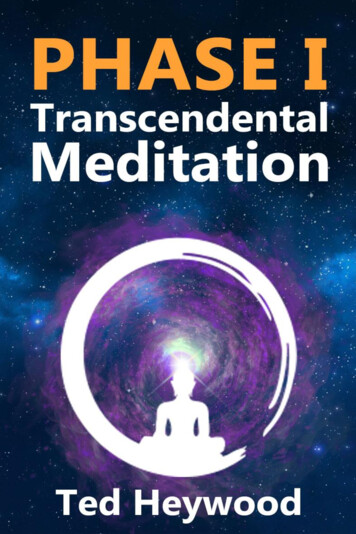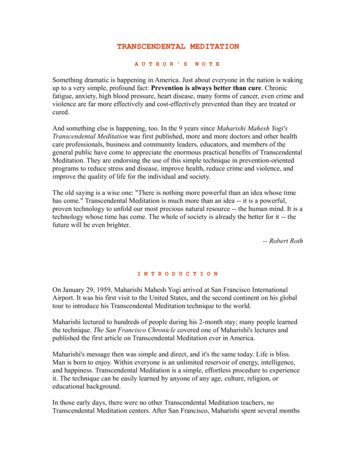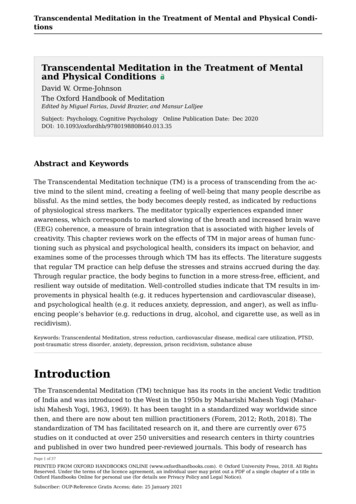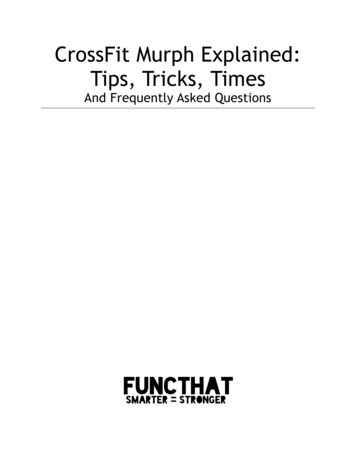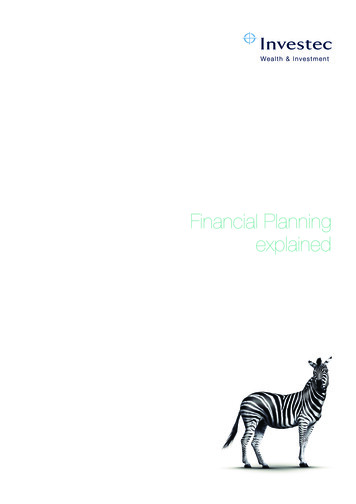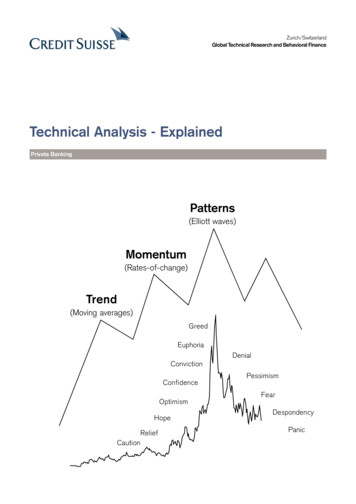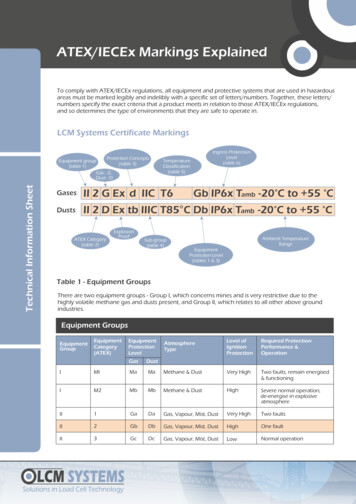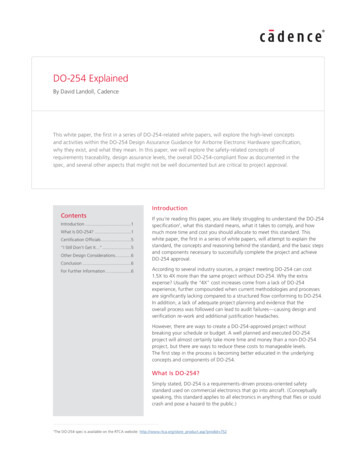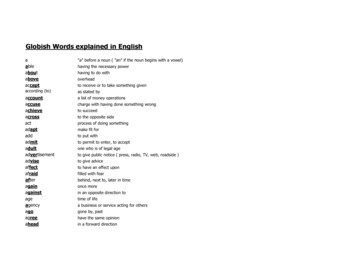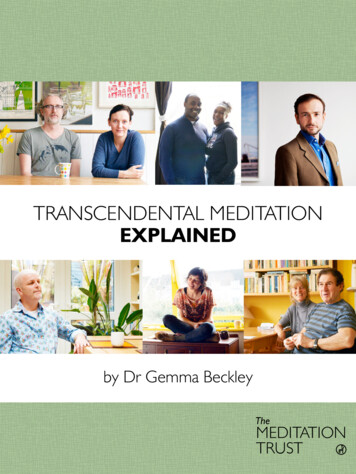
Transcription
TRANSCENDENTAL MEDITATIONEXPLAINEDby Dr Gemma BeckleyTheMEDITATIONTRUST
TRANSCENDENTAL MEDITATIONEXPLAINEDWritten by Dr Gemma BeckleyPublished by The Meditation Trustcopyright 2014 The Meditation TrustThis work can be shared only with full attribution and credits:www.meditationtrust.comCREATIVE COMMONSThis work is licensed under the Creative Commons AttributionNonCommercial-NoDerivatives 4.0 International License. To view acopy of this license, visit: ease note that the Meditation Trust has no connection with the Maharishi Foundation.
Transcendental Meditation ExplainedDr Gemma BeckleyDr Beckley teaches transcendental meditationwith the Meditation Trust, principally inLondon, and also practises part time as aClinical Psychologist in the NHS. She begantranscendental meditation at the age of 6, andafter many years began intensive practice andadvanced courses with the Meditation Trust in2001, culminating in several months of specificresidential teacher training in the methods laiddown by Maharishi Mahesh Yogi.Within her years of training as a Clinical Psychologist Dr Beckley worked in arange of settings including psychiatric hospitals, community mental healthteams, secure forensic services, learning disability services and specialist eatingdisorder services. Her approach to psychological therapies is integrative, beinginformed by positive psychology, solution focused therapy and ‘third wave’ CBTwhich incorporates mindfulness meditation practices. Dr Beckley’s Psychologyundergraduate research explored the effects of TM on occupational stress. Herprofessional doctorate thesis in Clinical Psychology explored the effects of TM onanxiety, depression and well being.Since becoming a teacher of transcendental meditation privately to the generalpublic, Dr Beckley not only teaches those with high levels of stress and a widerange of resulting mental and physical health problems, but also many hundredsof high achieving healthy and successful individuals who want to improve thequality of their lives in numerous ways and achieve their full potential.3
Transcendental Meditation ExplainedContentsWhat is TM?How to do TMHow is TM differentOrigins of TMTM mantrasFrequently asked questionsTM BenefitsRelief of StressEnhancement of LifeOn Health:AgeingAsthma and BreathingBlood PressureCancerCholesterolChronic FatigueHeart HealthInsomniaPainWeightOn Mental health:AddictionADHDAutismAnxiety & DepressionBereavementCognitive FunctioningPTSDHow to learn TMThe Meditation 4950515353555860
Transcendental Meditation ExplainedWhat is TranscendentalMeditation?Transcendental Meditation (TM) is the simplest, most naturaland effortless technique of meditation – so simple that theadult technique can be learned from the age of 10.But it is also the most advanced and fundamentally different approach becausethe simplicity is based on a profound and complete understanding of not just themind and its behaviour but also the body, and how the two interact during deepmeditation, something not understood in virtually any other approach. Thereforea maximum of 20 minutes, twice a day, sitting in a comfortable chair are all thatis required.This is why when Dr. Deepak Chopra, world-renowned speaker and author ofmore than 50 books on meditation and its associated practices, learned TM in1980 he called it ‘Real’ meditation because, he said, it represented a major breakthrough in interpretation of this very ancient knowledge.“I discovered TM in 1980. My friend Vinod and I called it ‘realmeditation’ because we felt that an undeniable breakthrough hadbeen made in a tradition that cashes in more on legends thanresults I remember being so taken with bewildered happiness thatI said ‘it’s true!’ just that.” Dr Deepak Chopra5
Transcendental Meditation ExplainedA simple, effortless Yoga for the mindThis knowledge of transcendence (traditionally known as yoga), which means themind settling effortlessly into silence, is the most powerful key to unlock yourinner potential for self-healing and personal growth because it is simple and naturaland therefore works for everyone. Frequently, those who have learned, or eventaught, other forms of meditation, are astonished when they learn TranscendentalMeditation that the simplicity and effectiveness of their new knowledge producesresults that may have eluded them for years.TM is not concentration or visualisation, nor is it control or even mindfulness.Using a mantra (or sound) upon which to gently and innocently rest our attention,we simply allow the mind the freedom to follow its natural tendency towardshappiness, and it will settle spontaneously into silence. This unique approach,passed on during personal instruction by a teacher trained as directed by MaharishiMahesh Yogi, comes from the ancient Vedic tradition of India.The resulting peace (sometimes, and increasingly, blissful) allows the body alsoto gain very deep rest (much deeper than sleep), in which it can dissolve even itsdeepest stresses accumulated as a result of life’s worst traumas. As we emergerefreshed and revitalised from the silence of meditation, this has the potential toproduce sometimes dramatic improvements in any area of our life, as indicatedby a vast and ever increasing body of research over the last 45 years. However,for most people, the biggest results come gradually and comfortably over time.Vedic MeditationTranscendental Meditation is Vedic meditation, which derives from the Vedictexts of India, first written down around 5000 years ago. Because the Vedas haveinspired the multitude of religious approaches collectively known as Hinduism,they are generally thought to be Hindu texts. But their ancestry in fact stretchesback millennia in the history of humanity, before the modern religious era, asan oral, scientific tradition, best known for giving us Yoga (the art of living) and6
Transcendental Meditation ExplainedAyurveda (the science of life).The word Veda is normally translated as science, knowledge, or truth, andcomprises the knowledge required by humanity to ‘live life in perfection’. This wascognised by yogis during the practice of Vedic meditation, brought to the surfaceof their minds and transmitted in chant form from generation to generation.The most notable lineage of teachers who passed on Vedic meditation is theShankaracharya tradition, including the great Veda Vyasa and Adi Shankara afterwhom it is named. Like all traditions it has had periods when the knowledgebecame distorted and was eventually restored to clarity by a great teacher.The most recent of these restorations was in the early 20th Century whenSwami Brahmananda Saraswati passed his clear perceptions of the reality ofVedic meditation to his disciple Maharishi Mahesh Yogi, to be brought out notjust to India but to the whole world. Wishing to distinguish this restoration fromthe misunderstandings prevalent for more than a thousand years, Maharishidid not call his teaching of Vedic meditation by that name, but instead called itTranscendental Meditation. This new name is a description of how the process ofVedic meditation (during which the mind settles beyond activity, or ‘transcends’)differs significantly from other practices.7
Transcendental Meditation ExplainedHow to do TranscendentalMeditationThe technique of Transcendental Meditation (TM) is not one of doing, it’s moreabout not doing. Because the mind is always searching for happiness, and theultimate happiness is found when the mind is silent, no effort is needed to makeit settle (no matter how busy your mind!). Thinking a mantra innocently allowsthe mind the freedom to seek its own natural happiness. Any control or focussingby the meditator only gets in the way. Because of this lack of effort, it can bepractised anywhere (even on busy public transport) by anyone of any background,education, beliefs (religious or otherwise).You are not asked to give anything up or change your lifestyle in any way. Yousimply sit comfortably (most people prefer a chair) and close your eyes for up to20 minutes, twice a day (the best investment you’ll ever make!).Transcendental Meditation is very simple but as a result verysubtle and delicate. It therefore cannot be learned from abook, DVD or online.Its effectiveness depends on the skilled instruction and guidance (usually free forlife) of a professionally qualified instructor who has meditated themselves for manyyears and undertaken extensive training, as directed by Maharishi Mahesh Yogi.Trying to take a shortcut to understanding will almost certainly end indisappointment. Because the simplicity of doing nothing is contrary to everythingelse we do in our lives, it is very easily misunderstood.8
Transcendental Meditation ExplainedHow is TranscendentalMeditation Different?A common mistake made by the casual observer is to think that all meditation isbasically the same. It is now clearly shown by scientific research that the varioustechniques of meditation differ not only in the actual mental process being used,but also in the very different effects that have been measured in the brain andtheir effect on our lives. So how is transcendental meditation different?In essence, there is one fundamental difference between TM and otherapproaches: Most meditation aims to control or train the mind by a way ofthinking. Transcendence, on the other hand, involves no concentration, control,or training. (It is counter-productive to try to force the mind to go somewhere italready wants to go naturally!)TM allows the mind to go beyond surface level thinking towards silence (thesource of thought) and concentration, focus and control as well as freedom andcreativity are the spontaneous results.A recent review of research has suggested three main categories ofmeditation:1. Focused Attention or concentration techniques (e.g. Zen, Qi gong,Vipassana) require effort to sustain controlled attention on an object, andtherefore are characterised by high frequency activity in the front and coreof the brain.9
Transcendental Meditation Explained2. Open Monitoring includes mindfulness-based techniques, inwhich all experiences are allowed to pass through awareness withoutmanipulation or control, but the mind is generally being trained to returnto the present moment by using an object, breath, or body as an anchor.These are characterised by theta activity primarily in the front of the brain.3. Automatic Self-Transcending (AST) involves neither concentration nortraining the mind. Automatic means innocence is the key here. Evaluation,control or manipulation will leave you caught up in thinking and preventtranscending. AST includes TM, and the occasional expert in othertechniques. It describes any technique which transcends (goes beyond)the steps of the meditation practice itself. Alpha brain waves (characteristicof reduced mental activity and relaxation) permeate the whole brain,which receives more oxygen. Increased blood flow to the front (which iscoordinating activity) while the core of the brain is more quiet, indicatesalertness in the midst of deep rest, the state of transcendental or pureconsciousness (pure silence!).So is Transcendental Meditation the best?Each meditation technique has its own benefits. The first two categories usethe conscious, surface level of the mind, training the mind to produce specificoutcomes. TM, however, is the most effective technique for transcending, whichmeans ‘going beyond’ this relatively surface level of thought to experience itssource. From here we spontaneously return to activity with the dynamic powerof nature’s silent, restful alertness which then supports all our thought, speechand action (experienced briefly as the ‘zone’ in sport) and thereby produce apotentially much greater range of mental, physical and spiritual benefits.Meta-analyses (statistical analysis of multiple research studies) have found that TMis more effective than other meditation or relaxation techniques in producing arange of results. Examples include:10
Transcendental Meditation Explained Reducing anxiety (Journal of Clinical Psychology, 1989)Increasing self actualisation (Journal of Social Behavior and Personality, 1991)Decreasing blood pressure (e.g. Current Hypertension Reports, 2007)Reducing addiction (Alcoholism Treatment Quarterly, 1994)How does TM differ from mindfulness?The purpose of mindfulness, deriving from Buddhist traditions, is gently trainingthe mind to be in the present moment. Whilst superficially appearing similar, TMand mindfulness are actually quite different. Rather than returning the attentionto the breath, body or other objects, it is the use of a specific mantra, or sound,in TM which liberates rather than trains the mind, allowing it to settle effortlesslyinto a silence more profound than the present moment.Increased mindfulness is just one of the many spontaneous effects of TM, asindicated by research: A 3-month randomised controlled trial found that thosepractising TM reported significantly greater increases in mindfulness than waitlistparticipants (Journal of Clinical Psychology, 2009).The full practice of meditation in the Yoga tradition was prevalent in India beforeand during the life of the Buddha. In this practice, the meditation itself is precededand nourished by mindfulness in the form of Asana (yoga postures) and Pranayama(breathing techniques) when, most importantly, attention on first body and thenbreath create a state of Pratyahara, movement of attention inwards, away fromthe world’s distractions.The practice of meditation that follows is then, if properly applied, a simple,effortless and automatic continuation of the flow of attention towards peaceful,blissful silence, like a river flowing spontaneously towards the ocean. Thisunderstanding of effortless meditation was revived in India in the 1950s byMaharishi Mahesh Yogi as transcendental meditation.11 pag
Transcendental Meditation is Vedic meditation, which derives from the Vedic texts of India, first written down around 5000 years ago. Because the Vedas have inspired the multitude of religious approaches collectively known as Hinduism, they are generally thought to be Hindu texts. But their ancestry in fact stretches back millennia in the history of humanity, before the modern religious era .File Size: 900KBPage Count: 60
